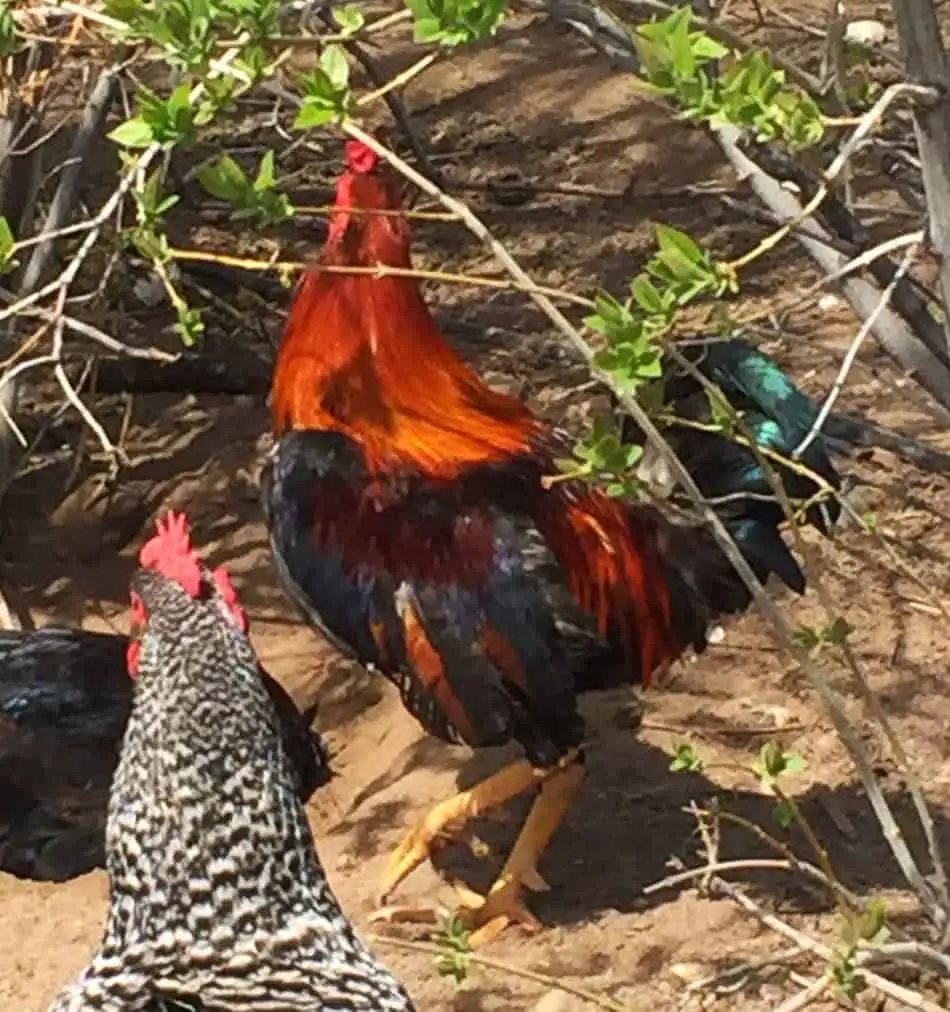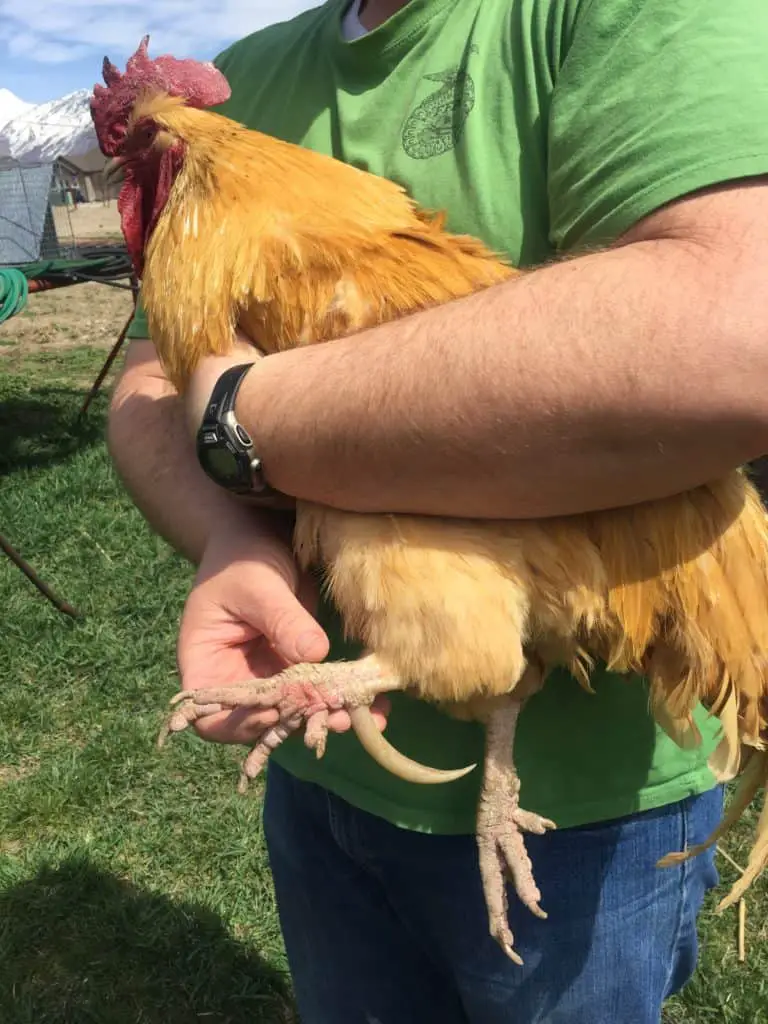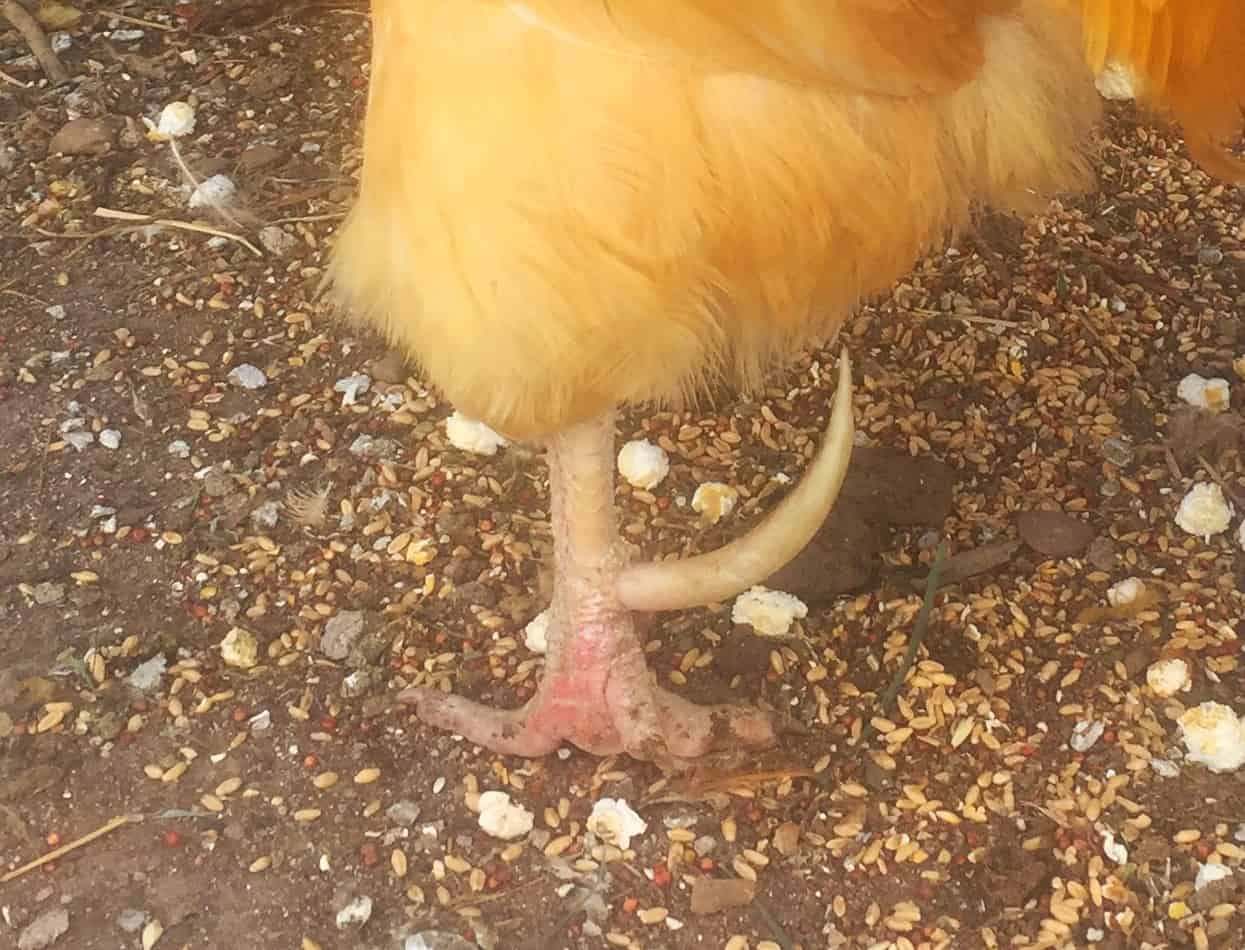Unless your flock consists of hens only, anyone raising backyard chickens will have to deal with roosters, and consequently, rooster spurs. The spurs of a rooster are its first line of natural defense, as well as a first line of defense for the flock against predators. For this reason, you will not want to remove a rooster’s spurs unless prompted by necessity. Typically a rooster’s spurs will not become a problem, and can be left alone. These spurs however can prove harmful to humans, hens or other roosters if a rooster becomes overly aggressive. In these instances, spur maintenance is essential to keeping a happy and healthy flock. This article describes the best methods for trimming or removing rooster spurs.
When I was eight years old, I was attacked and spurred by our family’s black australorpe rooster when I entered the coop one evening to gather eggs. Without warning or provocation, the rooster jumped into the air and spurred me on the top of the head, causing a rather serious wound. Needless to say, after the wound had been cleaned and dressed my father quickly “dispensed” of the bird, and I have been cautious of roosters ever sense. The point of this story? First off, if you are worried about an aggressive rooster in your flock, my first recommendation is to get rid of him. Some roosters are simply overly protective of their hens, and will attack other roosters, pets and humans if they perceive a threat. Though there are methods to train roosters to be submissive to humans, it is my advice that if you have a rooster showing overly-aggressive behavior, your flock (and your children) will be better off without him.
What are spurs?
Spurs typically only grow on roosters, however, in some breeds, hens may grow a small spur as well. This customarily occurs only in Mediterranean breeds, such as the Leghorn, Ancona, Minorca or Polish, or in hens of advanced age. In my backyard flock, two of my leghorn hens have developed a small spur on one leg.
All chickens, both hens and roosters, will develop a small bump or spur bud on the back of their shank bone just above the back claw at around three to six months of age. In hens, the spur bump will generally stay dormant and not grow. In roosters however, between three to eight months of age, the bump will develop and eventually grow longer and harder (covered in keratin) until it becomes a sharp spur.
Anatomically, a chicken spur is an extension of the bird’s shank bone covered by a sheath, or hard layer of keratin (the same protein material that makes up fingernails and hair). Like a fingernail, the keratin sheath is only supplied by blood at its base, thus allowing for trimming or the removal of the spur tip without causing injury to the bird. Remember however that the base is made of bone, so proper techniques should be followed to avoid permanent injury to the bird’s leg.

Why do roosters have spurs?
Roosters develop spurs for several reasons. As mentioned above, the first reason is for defense and protection. Roosters are instinctively territorial, and protective of their hens. A rooster will use its spurs to fight with any creature it perceives is a threat to its territory or harem. For many flock owners, this is precisely the reason for keeping a rooster or two with the flock. The rooster is a good line of defense, or watchdog against unwanted predators. If a rooster perceives a threat, on the ground or in the sky, he will often flap his wings, squawk, or crow, and if necessary attack the predator with his spurs. Roosters will often fight to the death to protect their flock.
Second, a rooster uses his spurs during mating. As a rooster mates with a hen, he climbs onto her back, grasping for balance with his claws and spur, and her neck feathers with his beak. If a rooster’s spurs are excessively long or curved, they can cause harm to the hen’s back and wings during mating. This is another good reason to keep your roosters spurs in check.
Unlike guinea hens or other monogamous birds, roosters are known to be rather aggressive philanderers. It therefore is wise to keep your hen to rooster ratio at about 12 to 1 to prevent over-mating. That being said, some roosters are simply rougher than others any may cause damage to his hens during mating. Keep an eye out for these types of injuries in your flock, as there are other measures (such as saddling) that can further protect your hens.
Third, a rooster will use his spurs to develop dominance within the flock. If a flock consists of more than one rooster, the two will likely face off from time to time to establish dominance and maintain a “pecking order”. Typically, the more aggressive rooster, or the rooster who best uses his sharp spurs will win the place of dominance. For this reason, if you choose to have more than one rooster in your flock, you will want to keep their spurs manageable so as to prevent them from seriously injuring or killing each other.

Finally, sometimes a rooster’s spurs will grow too long, and curl into such an angle, that the spur will cause damage to the rooster itself. We had a leghorn a few years back, whose right spur grew so long it curled and began to cut into his own leg, and effected his gait. This is rather common, and easily corrected. A simple trim had him back to normal in no time.
Sometimes, after displaying necessary aggression to fend off predators or to establish a place of dominance within a flock, a rooster may become overly aggressive. So, in order to protect yourself, your family, your hens, and even the less dominant rooster, it will be necessary to trim or remove the rooster’s spurs.
Should I trim or remove the spur? Or, should I leave it alone?
Some rooster’s spurs will not require any maintenance. They will grow to an appropriate length for him to be a threat to predators without causing harm or alarm to himself, you, or the flock. If however, you decide that your rooster’s spurs require maintenance, you will have a choice between filing, clipping, or removing the sheath. Most rooster’s spurs will grow back after removal, so spur maintenance and/or removal will need to be done annually. Most often however each time a spur grows back, it is smaller than the time before.
1. Filing: If you prefer to take the edge off or blunt your rooster’s spurs, filing may be the method you prefer. Simply use a metal file (purchased at any hardware or ranch store) and file the spur down as you would a fingernail. Many people prefer to use an automatic filer, grinder, or dremel tool, usually found in dog or pet supply stores. When filing with any type of tool, be careful to hold the rooster’s leg and spur steady, and not to file too much, as you may reach the “quick” of the spur and cause bleeding.
2. Clipping: Another method of maintaining a rooster’s spurs is simply clipping them when they grow too long. I have done this by using a set of sharp guillotine-style dog nail clippers. The trick is to make certain not to cut too far. You will want to do this in good lighting, so you will be able to determine where the inner bone which has a darker and whiter appearance begins. (similar to avoiding the quick when clipping a dog’s nails). If you clip too far, you risk cutting the bone and causing excessive or permanent damage. Many bird owners, use a combination of clipping and filing to ensure a good blunt edge to the spur.

3. Removal of Sheath: Because the spur is made up of a keratin sheath which surrounds bone, you can also maintain the spur by simply removing the sheath. There are various methods to remove the sheath, including twisting and pulling it off, using a hot potato to steam it off, or using oils to soften it until it is ready for removal.

- The simple twist and pull method is my preferred method, but may not work for all rooster spurs, as some are more securely attached than others. To attempt this method, it is best to use a pair of pliers to grasp the spur. (I use a pair of needle nose pliers). Then, once you have grasped the spur, gently twist it in a round-type motion until the spur sheath pops off. Exercise caution not to twist the rooster’s leg when attempting this method.
- The second method for spur removal involves a steamed potato. Simply microwave a potato until it is cooked through. Depending on the size of potato, this typically takes 3-5 minutes. (Do not puncture the potato with a fork as you might do when baking for consumption). Then, maneuver the spur onto the potato, so the entire spur is embedded inside of the baked potato and leave it for several minutes. (CAUTION: be careful not to touch the rooster’s leg with the potato as this will burn him). The steam from the heat and moisture inside of the potato will soften the spur, making it more pliable and ready for removal. After allowing the potato to work for several minutes, remove the potato, and then use the twist and pop method described above. You will find the spur easily slides off of the inner bone without causing pain or discomfort for the rooster.
- The third method also causes the spur to soften by using oil. This is done by coating the spur with olive oil especially at the base of the spur so the casing, or sheath connection will soften. We have done this by first, pouring the olive oil over the spur, and then covering the sheath with tinfoil and letting it sit for several minutes. The oil will soften the spur sheath enough that the grip and twist method is much easier.
How to catch, hold, and handle the rooster
Despuring your rooster may actually prove much easier than catching him! Many people have asked me how we catch our roosters when it is time to trim their spurs. Because our chickens are a free range flock, we wait until evening when the birds have roosted. Then, always using two people, we catch the rooster by approaching him from behind and from above, (with thumbs forming a “W”) certain to cover his wings with both hands (securing the wings will help you avoid causing undue harm to the rooster). He never likes being caught, and at times will try to claw or get away. Once caught, the second person wraps the rooster in a towel, so his wings are covered and his body secured.

If you have a more docile rooster, you can hold him under one arm. We have one Buff Orpington rooster (“Cogburn”) who lets us pick him up and hold him for the procedure, and anther one, a Marsh Daisy (“Ichabod”) that we have to work to catch. With the buff, we are able to perform the procedure rather easily and quickly, with the Marsh it’s a little more difficult.
How to Control Bleeding:
Regardless of the method you use to remove the rooster’s spurs, you may cause the bird to bleed. Though typically, (if performed correctly) the wound should not bleed much. The bleeding is caused because the spur sheath is connected to the flesh. The best method to control bleeding is to sprinkle blood stop powder or cornstarch over the wound, then spray the weeping flesh with blu kote or another form of vetericyn or anticeptic poultry spray, you can also use teramyacin powder on top of the blood slop or cornstarch to help stop bleeding.
Is there a way to remove spurs permanently?
If the idea of removing your rooster’s spurs each year seems daunting, it is possible to have a veterinarian remove the spur permanently. In chicks, it is possible to perform a cauterizing procedure. This essentially involves locating the chick’s spur bud, and cauterizing it. I do not recommend this procedure however, as I have heard stories of birds that have had this procedure performed growing misshapen or partial spurs, and of birds whose cauterization led to leg deformities and problems. In adult birds, the spur may be permanently removed by a veterinarian, who will put the bird under anesthesia (causing it to fall asleep), and use a bone saw to remove the spur bone and stitch over the remaining wound. Neither of these procedures should be performed as a DIY project, as the spur bone is directly connected to the bird’s leg bone, and if performed incorrectly, may lead to problems with the underlying leg bone, or infection.
How long will it take the rooster to recover?
It shouldn’t take long for your rooster to recover. After a day or two, the remaining spur bone will be coated over and protected. Typically, within only a few hours of removing his spurs, he will be back to his old self, clucking and strutting around the yard.

